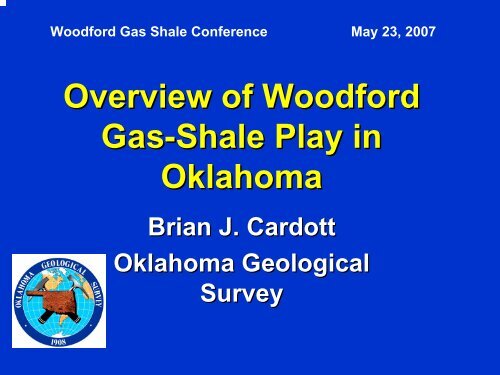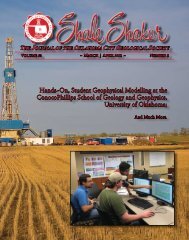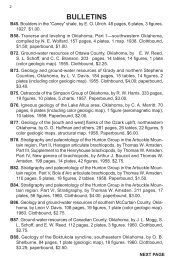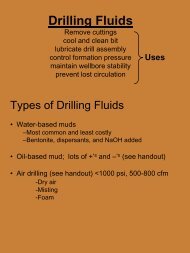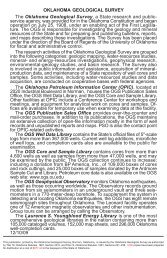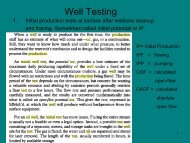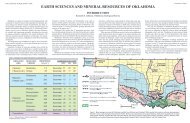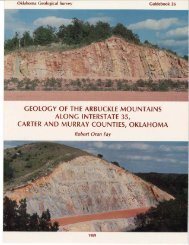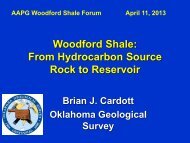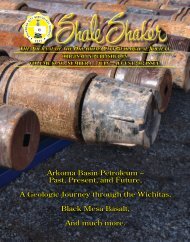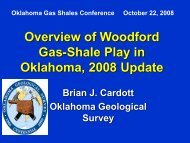Overview of Woodford Gas Shale Play - Oklahoma Geological Survey
Overview of Woodford Gas Shale Play - Oklahoma Geological Survey
Overview of Woodford Gas Shale Play - Oklahoma Geological Survey
Create successful ePaper yourself
Turn your PDF publications into a flip-book with our unique Google optimized e-Paper software.
<strong>Woodford</strong> <strong>Gas</strong> <strong>Shale</strong> Conference May 23, 2007<br />
<strong>Overview</strong> <strong>of</strong> <strong>Woodford</strong><br />
<strong>Gas</strong>-<strong>Shale</strong> <strong>Play</strong> in<br />
<strong>Oklahoma</strong><br />
Brian J. Cardott<br />
<strong>Oklahoma</strong> <strong>Geological</strong><br />
<strong>Survey</strong>
Taff (1902) introduced the name<br />
<strong>Woodford</strong> Chert for outcrops<br />
north <strong>of</strong> the town <strong>of</strong> <strong>Woodford</strong><br />
in southern <strong>Oklahoma</strong>.
WOODFORD CHERT: Taff (1902), Gould (1925),<br />
Wilmarth (1938), Dott (1952)<br />
WOODFORD FORMATION: Morgan (1924),<br />
Amsden (1957-1963), Wilson (1958), O’Brien and<br />
Slatt (1990)<br />
WOODFORD SHALE: Tarr (1955), Jordan (1957,<br />
1959, 1962), Urban (1960), Hass & Huddle (1965),<br />
Amsden (1975, 1980)
<strong>Woodford</strong> <strong>Shale</strong> Stratigraphy<br />
Based on conodonts, Hass and<br />
Huddle (1965) determined a Late<br />
Devonian (Frasnian) age for<br />
most <strong>of</strong> the formation;<br />
uppermost part is Early<br />
Mississippian (Kinderhookian)<br />
unconformity
Modified from Johnson and Cardott, 1992
Approximate distribution <strong>of</strong><br />
Misener Sandstone<br />
From Kuykendall and Fritz, 2001
Pre-<strong>Woodford</strong> Geologic Map<br />
From Amsden, 1980
Sylvan <strong>Shale</strong>?<br />
Pre-<strong>Woodford</strong><br />
Geologic Map<br />
Modified from OGS GM-9
<strong>Woodford</strong> <strong>Shale</strong> Members<br />
Three informal<br />
members based on<br />
palynomorphs<br />
(Urban, 1960;<br />
Von Almen, 1970),<br />
geochemistry<br />
(Sullivan, 1985),<br />
log signatures<br />
(Hester and others,<br />
1990; Lambert,<br />
1993)<br />
From Hester and others<br />
(1990) [Anadarko Basin]
<strong>Woodford</strong> <strong>Shale</strong> in southern<br />
Arbuckle Mountains
<strong>Woodford</strong> <strong>Shale</strong><br />
in southern<br />
Arbuckle<br />
Mountains<br />
Modified from Ellis and Westergaard, 1985
<strong>Woodford</strong> <strong>Shale</strong> Marker 9 ft below<br />
gradational contact with Sycamore<br />
Formation
From Conant and Swanson, 1961
Paleogeography and Facies Distribution<br />
in the Late Devonian<br />
From Kirkland and others, 1992
From Amsden, 1989
Isopach Map <strong>of</strong> <strong>Woodford</strong> <strong>Shale</strong><br />
From Comer, 1992
<strong>Woodford</strong> <strong>Shale</strong> Mineralogy<br />
O’Brien and Slatt (1990; Carter County):<br />
63% quartz, 3% plagioclase feldspar, 10%<br />
calcite, 6% dolomite, 5% pyrite, 14% total<br />
layer silicates.<br />
Kirkland and others (1992; Arbuckle<br />
Mountains): 55-87% quartz, 0-7% K-feldspar,<br />
0-3% dolomite, 0-1% apatite, 0-1% pyrite, 8-<br />
34% illite, 3-7% kaolin
<strong>Woodford</strong> <strong>Shale</strong><br />
is the oldest<br />
rock in<br />
<strong>Oklahoma</strong> that<br />
contains wood<br />
(vitrinite)<br />
from the<br />
progymnosperm<br />
Archaeopteris<br />
(organ genus<br />
Callixylon)
<strong>Gas</strong> <strong>Shale</strong>s<br />
<strong>Gas</strong> shales are varieties <strong>of</strong> hydrocarbon source rocks (an<br />
important part <strong>of</strong> a petroleum system).<br />
HYDROCARBON SOURCE ROCK CLASSIFICATION<br />
Organic matter type refers to the kerogen or maceral type<br />
and can be lumped into gas generative (Type III), oil<br />
generative (Type(<br />
Types s I and II), or inert (Type IV).<br />
Organic matter quantity is determined by the total organic<br />
carbon (TOC) content (weight percent, whole-rock basis).<br />
Vitrinite reflectance (%Ro, oil immersion) is the most<br />
common thermal maturity indicator. Vitrinite is a maceral<br />
derived from the woody tissues <strong>of</strong> vascular plants. The<br />
oil window is considered to be from 0.5–1.35% Ro.
<strong>Woodford</strong> <strong>Shale</strong><br />
From Comer, 1992
<strong>Gas</strong> <strong>Shale</strong>s<br />
Definition: : <strong>Gas</strong> shales are organic-rich, rich, fine-<br />
grained sedimentary rocks (shale to siltstone)<br />
containing a minimum <strong>of</strong> 0.5 wt % TOC.<br />
<strong>Gas</strong> shales may be thermally marginally-mature<br />
mature<br />
(0.4–0.6% 0.6% Ro) to mature/post-mature<br />
(0.6–>2.0%<br />
Ro) and contain biogenic to thermogenic methane.<br />
<strong>Gas</strong> is generated and stored in situ in gas shales<br />
as both adsorbed (on organic matter) and free gas<br />
(in fractures and pores). As such, gas shales are<br />
self-sourced sourced reservoirs. Low-permeable<br />
shales<br />
require extensive fractures (natural or induced) to<br />
produce commercial quantities <strong>of</strong> gas.
Questions to Resolve<br />
• What is the minimum thermal maturity<br />
needed for shales containing oil-generative<br />
organic matter (Types I and II Kerogen) ) to<br />
be economic gas shales?<br />
[>1.10-1.3%VRo]<br />
1.3%VRo]<br />
• What is the importance <strong>of</strong>:<br />
• natural vs. induced fractures?<br />
• free gas vs. sorbed gas?<br />
• mineralogy?
PEAK OIL GENERATION<br />
OIL FLOOR<br />
PEAK WET GAS GENERATION<br />
PEAK DRY GAS GENERATION<br />
WET GAS FLOOR<br />
DRY GAS GENERATION LIMIT<br />
DRY GAS PRESERVATION LIMIT<br />
Modified from Dow<br />
(1977), Houseknecht<br />
and Spötl (1993), and<br />
Taylor and others<br />
(1998)
Guidelines for the Barnett <strong>Shale</strong><br />
VRo Values Maturity<br />
1.40% Dry-<strong>Gas</strong> Window<br />
From Jarvie and others, 2005
Type II Kerogen <strong>Gas</strong> Generation<br />
(Hydrous Pyrolysis)<br />
1.0<br />
0.9<br />
0.8<br />
0.7<br />
0.6<br />
0.5<br />
0.4<br />
0.3<br />
Oil<br />
Generation<br />
(Hunt et al., 1991)<br />
0.6-<br />
1.1% Ro<br />
93% gas by 1.5% Ro<br />
75% gas by 1.1% Ro<br />
Source-Rock <strong>Gas</strong><br />
(Knauss et al. 1997)<br />
0.5-2.2% Ro<br />
Oil-Cracking <strong>Gas</strong><br />
Tsuzuki et al., 1999)<br />
1.6-3.3% Ro<br />
0.2<br />
0.1<br />
0.0<br />
Heating Rate = 5 o C/ m.y.<br />
Surface Temp. = 15 o C<br />
S.R. Age = 80 Ma o<br />
0.0 0.5 1.0 1.5 2.0 2.5 3.0 3.5 4.0<br />
Vitrinite Reflectance (% Ro)<br />
Figure 1: Generation <strong>of</strong> oil and gas from an 80-Ma source rock with Type-II<br />
kerogen and associated crude oil. Curves are based on kinetic parameters<br />
determined by hydrous and hydrothermal pyrolysis and EASY%Ro (Swweeney and<br />
Burnham, 1990).<br />
From Lewan, 2002
<strong>Gas</strong> Generation by Kerogen Type<br />
3.0<br />
2.5<br />
2.0<br />
1.5<br />
1.0<br />
Thermogenic <strong>Gas</strong> from<br />
Source Rocks<br />
Mahogany (Type-I)<br />
New Albany (Type-II)<br />
Ghareb-Israel (Type-IISi)<br />
Ghareb-Jordan (Type-IISj)<br />
Wilcox Lignite (Type-III)<br />
At 350°C for 72 h,<br />
Type-I and -II<br />
kerogens<br />
generate 1.8 times<br />
as much<br />
thermogenic gas<br />
as Type-III<br />
kerogen<br />
0.5<br />
0.0<br />
150 200 250 300 350<br />
o<br />
Hydrous Pyrolysis Temperature for 72 Hours ( C)<br />
Figure 2: Volume <strong>of</strong> hydrocarbon gas (C1-C5) generated by hydrous pyrolysis<br />
from thermally immature source rocks bearing different kerogen types (Lewan<br />
and Henry, 2001).<br />
From Lewan, 2002
U.S. <strong>Shale</strong> <strong>Gas</strong> Basins<br />
Source: Schlumberger shale gas white paper, 2005
Geologic Provinces <strong>of</strong> <strong>Oklahoma</strong>
Vitrinite Reflectance <strong>of</strong> <strong>Woodford</strong> <strong>Shale</strong>,<br />
Anadarko Basin<br />
From Cardott, 1989
Structure and Vitrinite Reflectance <strong>of</strong><br />
<strong>Woodford</strong> <strong>Shale</strong>, Anadarko Basin<br />
1.3% Ro<br />
From Cardott and<br />
Lambert, 1985
Structure and Vitrinite Reflectance <strong>of</strong><br />
<strong>Woodford</strong> <strong>Shale</strong>, Southern <strong>Oklahoma</strong><br />
Cardott, in preparation
0.61 0.66<br />
0.58<br />
0.63<br />
0.55<br />
0.60<br />
0.55<br />
0.58<br />
0.49<br />
0.58<br />
0.56<br />
0.82<br />
0.69<br />
0.50 0.50<br />
0.64<br />
0.70<br />
2.13<br />
2.19<br />
0.52<br />
0.49 2.22<br />
0.56 2.45<br />
0.54<br />
0.49<br />
0.77<br />
0.52<br />
0.63<br />
0.56<br />
0.58<br />
Suppressed<br />
Reflectance?<br />
0.53<br />
0.55<br />
0.55
Reflectance<br />
Suppression<br />
Southern<br />
<strong>Oklahoma</strong><br />
<strong>Woodford</strong> VRo<br />
suppressed by<br />
0.17-0.44% Ro
0.50% Rm<br />
HI=500<br />
@0.68% Rc<br />
0.50% Rm<br />
HI=700<br />
@0.83% Rc<br />
0.51% Rm<br />
HI=460<br />
@0.68% Rc<br />
0.49-0.52% Rm<br />
HI=800<br />
@0.93% Rc<br />
0.56% Rm<br />
HI=600<br />
@0.83% Rc<br />
0.58% Rm<br />
HI=700<br />
@0.96% Rc<br />
0.55% Rm<br />
HI=500<br />
@0.75% Rc<br />
Corrected<br />
Reflectance<br />
Rm=measured<br />
Rc=corrected
Southern <strong>Oklahoma</strong> VRo vs Depth<br />
Vitrinite Reflectance (%Ro)<br />
0.00 0.50 1.00 1.50 2.00 2.50 3.00<br />
0<br />
2,000<br />
4,000<br />
Depth (feet)<br />
6,000<br />
8,000<br />
10,000<br />
12,000<br />
14,000<br />
16,000<br />
18,000<br />
20,000
0.50% Rm<br />
Tasmanites<br />
green<br />
fluorescence<br />
0.50% Rm<br />
Tasmanites<br />
green<br />
fluorescence<br />
0.49-0.52% Rm<br />
Tasmanites<br />
green<br />
fluorescence<br />
0.56% Rm<br />
Tasmanites<br />
green<br />
fluorescence<br />
Tasmanites green<br />
fluorescence indicates<br />
immature thermal maturity
Map prepared<br />
by R. Vance<br />
Hall using<br />
Petra<br />
Generalized Structure<br />
Map <strong>of</strong> <strong>Woodford</strong><br />
<strong>Shale</strong>, Eastern<br />
<strong>Oklahoma</strong>
Vitrinite Reflectance <strong>of</strong> <strong>Woodford</strong> <strong>Shale</strong>,<br />
Eastern <strong>Oklahoma</strong><br />
Cardott, in preparation
Isoreflectance Map <strong>of</strong> the <strong>Woodford</strong><br />
<strong>Shale</strong> in Eastern <strong>Oklahoma</strong><br />
Map prepared<br />
by R. Vance<br />
Hall using<br />
Petra<br />
Cardott, in<br />
preparation
Oil and <strong>Gas</strong> Fields Map <strong>of</strong> <strong>Oklahoma</strong><br />
From Boyd, 2006
Number <strong>of</strong> Wells<br />
2010<br />
2005<br />
2000<br />
80<br />
70<br />
60<br />
50<br />
40<br />
30<br />
20<br />
10<br />
0<br />
<strong>Woodford</strong> <strong>Shale</strong> GAS Wells<br />
1930<br />
1935<br />
1940<br />
1945<br />
1950<br />
1955<br />
1960<br />
1965<br />
1970<br />
1975<br />
1980<br />
1985<br />
1990<br />
1995<br />
143 Wells, 1939–2006<br />
Year
<strong>Woodford</strong> <strong>Gas</strong> <strong>Shale</strong>s<br />
1939–2006<br />
553 ft<br />
15,310 ft<br />
(IP 234 Mcf;<br />
7BO 42° API;<br />
GOR 33,429)<br />
143 Wells<br />
3 Caney/<strong>Woodford</strong><br />
3 Sycamore/<strong>Woodford</strong>
<strong>Woodford</strong> <strong>Gas</strong> <strong>Shale</strong>s<br />
1939-1996<br />
100,000<br />
Gruy Petroleum 3 Griffin-Olmstead<br />
(Marshall CO, 16-5S-5E; IP 747 Mcfd; 4,052-4,135 ft)<br />
Madill Field<br />
10,000<br />
<strong>Gas</strong> Production (mcf)<br />
Average Monthly<br />
Rates<br />
Production (Mcf)<br />
1,000<br />
Oil Production (bbl)<br />
<strong>Gas</strong> Production (mcf)<br />
Water Production (bbl)<br />
Cumulative <strong>Gas</strong><br />
Production<br />
1,747,709 Mcf<br />
Completed as OIL well in McLish 6,536-6,544 ft on 11/4/55;<br />
OIL-WO well in McLish and Bromide 5,664-5,696 ft on 5/18/56;<br />
GAS-WO to <strong>Woodford</strong> on 3/21/92<br />
100<br />
1992 1994 1996 1998 2000 2002 2004 2006 2008<br />
(<strong>Gas</strong> production data supplied by Petroleum<br />
Information/Dwights LLC dba IHS Energy Group,<br />
© 2006, IHS Energy Group)<br />
Time
Verdad Oil & <strong>Gas</strong> 1 Mary Haynie<br />
(Bryan CO, 22-6S-7E; IP 962 Mcfd; 3,710-4,054 ft)<br />
1,000,000<br />
346 MMcf<br />
Aylesworth<br />
Field<br />
Average Annual<br />
Production (Mcf)<br />
100,000<br />
75 MMcf<br />
10,000<br />
1,000<br />
Completed as GAS well in Misener<br />
4,192-4,227 ft on 6/27/58; GAS-WO<br />
(plugback) in <strong>Woodford</strong> on 11/22/74<br />
Cumulative<br />
Production<br />
2,288,394 Mcf<br />
100<br />
1970<br />
1973<br />
1976<br />
1979<br />
(<strong>Gas</strong> production data supplied by Petroleum<br />
Information/Dwights LLC dba IHS Energy Group,<br />
© 2006, IHS Energy Group)<br />
1982<br />
1985<br />
1988<br />
Date<br />
1991<br />
1994<br />
1997<br />
2000<br />
2003<br />
2006
<strong>Woodford</strong> <strong>Gas</strong> <strong>Shale</strong>s<br />
2004–2006<br />
122 Wells<br />
3 Caney/<strong>Woodford</strong><br />
2 Sycamore/<strong>Woodford</strong>
10,000<br />
<strong>Woodford</strong><br />
<strong>Woodford</strong> Horizontal<br />
Initial Potential (Mcfd)<br />
1,000<br />
100<br />
10<br />
Depth: 553-15,310 ft; IP: 6-6,897 Mcfd<br />
1<br />
0 2,000 4,000 6,000 8,000 10,000 12,000 14,000 16,000<br />
Depth (feet)
10,000,000<br />
<strong>Woodford</strong> <strong>Shale</strong> Production (2004-2006 wells)<br />
1,000,000<br />
100,000<br />
10,000<br />
1,000<br />
100<br />
<strong>Gas</strong><br />
Oil<br />
Cumulative Production<br />
11,757,701 Mcf gas,<br />
9,048 BBLS oil/condensate<br />
from 98 wells (excludes 11 OWWO)<br />
10<br />
Jan-04<br />
Mar-04<br />
May-04<br />
Jul-04<br />
Sep-04<br />
Nov-04<br />
Jan-05<br />
Mar-05<br />
May-05<br />
Jul-05<br />
Sep-05<br />
Nov-05<br />
Jan-06<br />
Mar-06<br />
May-06<br />
Jul-06<br />
Sep-06<br />
Nov-06<br />
Average Monthly Production (Mcf)<br />
(<strong>Gas</strong> production data supplied by PI/Dwights LLC,<br />
© 2007, IHS Energy Group)<br />
Date
<strong>Woodford</strong> <strong>Shale</strong> Oil/Condensate Production<br />
(2004-2006 wells)<br />
@1.3% Ro<br />
@0.75% Ro<br />
@0.6% Ro<br />
40° API oil<br />
GOR 22,776<br />
@0.6% Ro<br />
GOR 41,210<br />
@1.3% Ro<br />
55° API condensate<br />
GOR 87,555<br />
@1.4% Ro
http://www.ogs.ou.edu<br />
For more information,<br />
please visit the<br />
<strong>Oklahoma</strong> <strong>Geological</strong><br />
<strong>Survey</strong> Web Site
THANK YOU<br />
Typical Calf Creek point <strong>of</strong> <strong>Woodford</strong> chert found<br />
in Haskell County, <strong>Oklahoma</strong><br />
(Norman Transcript, March 11, 2007, p. E1)


